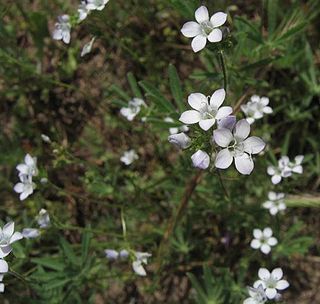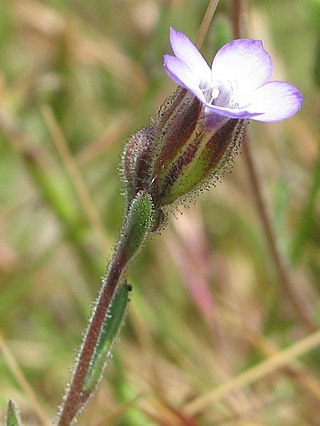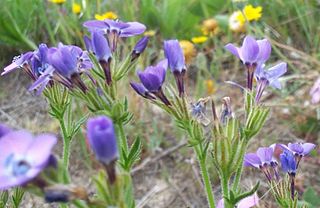
Juncus tenuis, the slender rush, is a clump-forming, round-stemmed perennial in the Juncaceae. Slender rush grows to be between 15 and 60 cm tall. Generally considered a weed, it is rarely sold by retailers as a household container plant. Where it is introduced, it is colloquially called path rush, field rush, slender yard rush, poverty rush or wiregrass.

Gilia is a genus of between 25 and 50 species of flowering plants in the Polemoniaceae family and is related to phlox. These Western native plants are best sown in sunny, well-draining soil in the temperate and tropical regions of the Americas, where they occur mainly in desert or semi-desert habitats

Gilia angelensis is a species of flowering plant in the phlox family known by the common name chaparral gilia. It is native to the coastal hills and mountains of California and Baja California, where it is a member of the chaparral ecosystem., especially in the Transverse Ranges.

Gilia cana is a species of flowering plant in the phlox family known by the common name showy gilia. It is native to California and Nevada where it grows in open areas with gravelly and sandy soils, such as desert and rocky slopes. The Mojave Desert range of some subspecies may extend into Arizona.

Gilia capitata is a species of flowering plant in the phlox family known by the common names blue-thimble-flower, bluehead gilia, blue field gilia, and globe gilia.

Gilia millefoliata is a species of flowering plant in the phlox family known by the common name manyleaf gilia. It is native to the coastline of Oregon and northern California, where it grows in sand dune habitat.

Gilia tenuiflora is a species of flowering plant in the phlox family known by the common name greater yellowthroat gilia. It is endemic to California, where its distribution spans the central coast and coastal mountains, as well as the Channel Islands.

Aliciella is a genus of plants in the phlox family. These plants have been treated as members of genus Gilia until recently, when it was proposed they be moved back to Aliciella. This genus was created in 1905 to include certain gilias that seemed distinct from most of the others, but it was abandoned soon after. Recent genetic analyses suggest it should be revived.

Aliciella leptomeria is a species of flowering plant in the phlox family known by the common names sand gilia and Great Basin gilia. It is native to the Western United States, where it grows in many types of habitat, such as the sagebrush of the Great Basin and in the Mojave Desert.

Linanthus maculatus is a species of flowering plant in the phlox family known by the common names San Bernardino Mountain gilia and Little San Bernardino Mountains gilia. It is endemic to California, where it is known only from a few locales in the Little San Bernardino Mountains and the adjacent Palm Springs area in the northern end of the Coachella Valley. The largest populations, which may contain thousands of individuals, are located within the bounds of Joshua Tree National Park. This is a very small annual herb no more than three centimeters high. It has a taproot which may exceed 6 centimeters in length to collect moisture from the dry desert sand in its native habitat. The tiny, hairy stem branches to form small matted clusters on the sand surface. The hairy leaves are just a few millimeters long and unlobed. The inflorescence is a dense cluster of flowers each only 2 to 5 millimeters wide. The flower corolla has curled-back lobes which are white, sometimes with a spot of purple or pink. The protruding stamens are yellow. The main threat to this species is development in its range, and it is also vulnerable to off-road vehicle damage in the wide open sandy flats where it grows.

Gilia salticola is a species of flowering plant in the phlox family known by the common name salt gilia. It is native to the Sierra Nevada and Modoc Plateau of California and western Nevada, where it grows in volcanic and granitic soils.
The Bonny Doon Ecological Reserve is a nature preserve of 552 acres (2.23 km2) in the Santa Cruz Mountains of California, United States. The reserve protects several rare and endangered plant and animal species within an area known as the Santa Cruz Sandhills, an ancient seabed containing fossilized marine animals.
Navarretia rosulata is a rare species of flowering plant in the phlox family known by the common names San Anselmo navarretia, Marin County navarretia, and Marin County pincushionplant.
Gilia yorkii is a rare species of flowering plant in the phlox family known by the common names Boyden Cave gilia and monarch gilia. It is endemic to Fresno County, California, where it is known from only one location in the southern Sierra Nevada. This plant grows in rock cracks in the limestone cliffs and outcrops in the chaparral and woodlands of the canyon.

Eutrema penlandii is a rare species of flowering plant in the mustard family known by the common names Mosquito Range mustard, Penland's alpine fen mustard and Penland's eutrema. It is endemic to Colorado in the United States, where it is known only from a small strip of unique mountain habitat measuring 40 kilometers long. It is threatened by mining and associated environmental changes in this part of the Continental Divide in central Colorado. The plant was federally listed as a threatened species of the US in 1993.
Aliciella sedifolia is a rare species of flowering plant in the phlox family known by the common name stonecrop gilia. It is endemic to Colorado in the United States, where it is limited to a small area in the San Juan Mountains.
Aliciella formosa is a species of flowering plant in the phlox family known by the common name Aztec gilia. It is endemic to New Mexico in the United States, where it is known only from San Juan County.

Aliciella caespitosa is a species of flowering plant in the phlox family known by the common names Rabbit Valley gilia and Wonderland Alice-flower. It is endemic to Utah, where it is known only from Wayne County.
Aliciella penstemonoides is a species of flowering plant in the phlox family known by the common names Black Canyon gilia and beardtongue gilia. It is endemic to Colorado in the United States.













